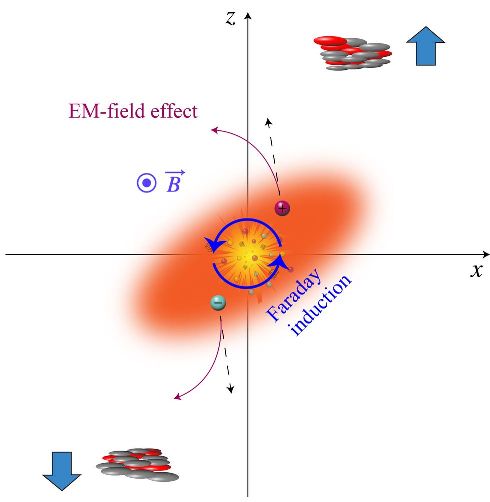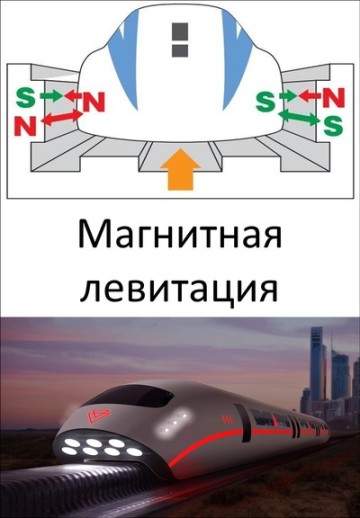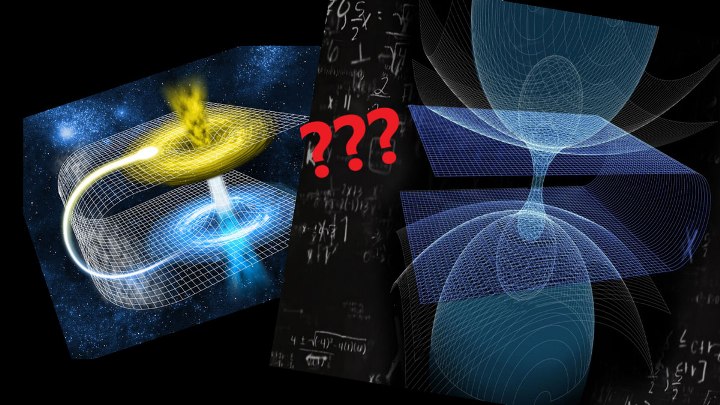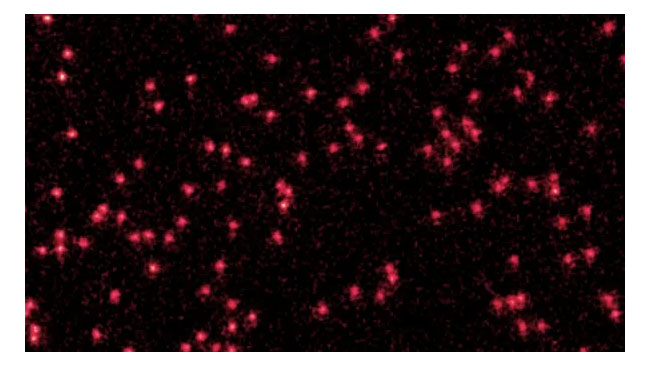Scientists smashed atom against atom and unleashed a magnetic monster. A groundbreaking experiment has created a field so strong it could eclipse the grip of a neutron star. Rotating magnets can create levitation that is almost impossible to physics. For the first time, physicists had a clear understanding of how individual atoms behave like waves.
The universe is a place of strong magnetic extremes. Magnetars, for example, can generate magnetic fields of more than 100 trillion gauss—by comparison, the magnet on your refrigerator produces a field of just 100 gauss. This extremely intense magnetism can distort the star’s shape to the point that the star emits gravitational waves into the universe. But this space-time-altering magnetic field doesn’t even come close to the power of the fields generated in the quantum world.
The magnetic field created by scientists was about 10,000 times stronger than that of a magnetar
New research from Brookhaven National Laboratory’s Solenoidal Tracker at RHIC (STAR) experiment using the Relativistic Heavy Ion Collider in Upton, New York, has detected a “super strong” magnetic field inside the quark-gluon plasma formed after the center was turned off. collisions of heavy atomic nuclei. According to results published last week in the journal Physical Review X, this magnetic field was about 10,000 times stronger than that of a magnetar.
“These fast-moving positive charges should generate a very strong magnetic field, predicted to be 10 18 gauss,” co-author Gang Wang, a STAR physicist at UCLA, said in a press statement. “This is probably the strongest magnetic field in our Universe.”
Using an RHIC the size of a house, scientists tracked the collision trajectories of heavy ions (such as gold) after an off-center collision. Theories predict that such a collision would create a strong magnetic field—some positively charged protons and neutral neutrons not involved in the collision would swirl in the resulting quark-gluon plasma as they passed at close to the speed of light.
After ruling out other causes for such a strong magnetic field, the researchers discovered a “charge-dependent deflection” that could only be caused by a phenomenon known as Faraday induction (named after the famous 19th-century pioneer of electromagnetism). This specific induction can only be caused by the rapid decay of a strong magnetic field. The interaction affected the trajectory of the charged particles, which scientists were then able to measure.

Top-down view of an off-center collision. Figure (B) represents a super-strong magnetic field as it decays, which induces an electric current through Faraday induction. This affects the trajectory of charged particles captured by the RHIC. The magnitude of the deviation is related to the conductivity of the quark-gluon plasma.
And that’s a good thing, because unlike magnetars, which simply produce powerful magnetic fields throughout their entire lives, these super-strong magnetic fields resulting from off-center collisions only occur for ten millionths of a billionth or billionth of a second. This makes it impossible to capture on its own, but its effect can be seen in the resulting scatter of subatomic particles.
“We can infer the conductivity value from our measurements of collective motion,” co-author Diyu Shen, a STAR physicist at Fudan University in China, said in a press statement. “The degree to which particles are deflected directly depends on the strength of the electromagnetic field and the conductivity in the QGP—and no one has measured the conductivity of the QGP before.”
Understanding the properties of quark-gluon plasma helps physicists understand what the Universe was like just moments after the Big Bang, before free-moving quarks and gluons coalesced into hadrons—protons and neutrons—that form atoms. These collisions should also help experts study the complexity of the magnetic chirality effect (CME).
It turns out that rotating magnets can create levitation that is almost impossible to physics
Gravity is not taken into account in principle in the new principle of magnetic levitation based on rotation that is being developed. This spin-stabilized levitation uses a spinning magnet to stabilize the levitating magnet and lock it in place.
Magnetic levitation is already in use around the world, and the new principle has applications involving non-contact handling of objects.

Gravity is essentially not part of the physics equation when spin-stabilized levitation comes into play. As research continues to develop a new type of magnetic levitation, which consists of a spinning rotor magnet that levitates a float above it, scientists have concluded that this new type of anti-gravity levitation has real-world applications.
First demonstrated in 2021 by Turkish electronics engineer Hamdi Ukar, a research team from the Technical University of Denmark expanded on the concept of counter-gravity, publishing their findings in the journal Physical Review Applied in October 2023. In their research, the team demonstrated how easy this concept is to create and replicate.
They also showed what amazing and unexpected physics makes this whole process happen.
Magnetic levitation (sometimes called maglev) has already been observed all over the world, from floating trains to high-speed cars. But spin-stabilized levitation could simplify future uses of magnetic levitation due to its compatibility with non-contact design. Modern maglev models require control systems to supply magnetic force and conduct energy flows. Instead, this new approach only requires rotating one magnet to hold the other in place.
“The magnets should not hang up when they are placed close to each other,” said Rasmus Björk, study leader and physicist at TU-Denmark, according to The Debrief. “Usually they either attract or repel each other. But if you twist one of the magnets, it turns out that you can achieve real freezing. And this is the strangest thing. The force on magnets shouldn’t change just because you spin one of them, so there seems to be a relationship between motion and magnetic force.”

The rotor magnet rotates. If the motor can keep the rotor magnet moving, it can do the work of keeping another magnet, called a float, levitated. “We found that when levitation occurs,” the authors write in the study, “the frequency of the float magnet is synchronized with the rotor magnet and, remarkably, the magnetization of the float is oriented close to the rotation axis of the rotor magnet pole.”
But why? Well, contrary to what one would expect from the laws of magnetostatics, it turns out that the float aligns its magnetization essentially perpendicular to the rotor’s magnetic field.
“It’s quite surprising that magnetic levitation develops in such a relatively simple system,” Björk told Physics World.
This discovery means that the float can levitate stably due to interaction. “Everyone intuitively understands that the magnetostatic force that one magnet exerts on another can be either attractive or repulsive,” Frederic Laust Durhus, study leader and physicist at TU-Denmark, told Physics World. “Without rotation, a free magnet will rotate, so the force will become purely attractive, and then the magnets will collide with each other. What makes the new magnetic levitation system so special is that the rotation itself allows the float to remain in a contradictory configuration, almost perpendicular to the float’s field, where the magnetostatic force simultaneously attracts and repels it.”
Such a setup could prove useful for everything from magnetic particle capture to non-contact robotic applications, thanks to a setup that is significantly simplified compared to current-dependent systems.
“The key thing about our experiment demonstrating magnetic levitation,” Björk told Physics, “is how extremely simple it is to implement.”
In search of quantum gravity
Levitation of magnets at sub-zero temperatures could lead to revolutionary space discoveries. Einstein couldn’t crack the code of quantum gravity. Scientists are one step closer. Although three of the four fundamental forces of nature can be found in the quantum world, gravity remains the only outsider.
A new experiment conducted by an international team of European scientists has recorded the smallest gravity measurement ever recorded – just 30 attoNewtons (aN).
By measuring a particle weighing just 0.43 mg, future measurements could penetrate the quantum world and reveal the ever-elusive quantum gravity.
Einstein’s theory of general relativity has helped redefine our understanding of how massive bodies in the universe interact and influence the structure of space-time, and quantum field theory defines the atomic world.
While these two theories describe their worlds well (though there is always room for improvement), they don’t fit well together, which is quite a problem if you want to unify the physics of the cosmos under one set of theories and rules. While the physical world contains evidence of four fundamental forces—electromagnetism, the weak nuclear force, the strong nuclear force, and gravity—the quantum world exhibits only the first three. That’s why physicists have been looking for any evidence related to quantum gravity for almost a century.

This search for quantum gravity has baffled the greatest minds, including Einstein himself, who said in his General Theory of Relativity that there was no experiment to prove quantum gravity. Although Einstein was one of the most gifted physicists who ever lived, his predictions did not always come true. Einstein once thought it was likely impossible to ever detect gravitational waves, and now LIGO has a growing list of them. So, could Einstein be wrong about quantum gravity experiments?
An international team of scientists from Britain’s University of Southampton, Leiden University in the Netherlands and the Italian Institute of Photonic and Nanotechnology are eager to find out. In a new study published in the journal Science Advances, the team details the innovative process by which they discovered the smallest gravity ever recorded. Gravity was detected on a tiny particle measuring just 0.43 mg. It’s not exactly a quantum world, but it’s so small it’s almost adjacent to it.
“For a century, scientists have tried and failed to understand how gravity and quantum mechanics work together,” Tim Fuchs of the University of Southampton, lead author of the study, said in a press statement. “We have now successfully measured gravitational signals at the smallest mass ever recorded, meaning we are one step closer to definitively understanding how it works in tandem. From here we will begin to scale down the source using this technique until we reach the quantum world on both sides.”
Like most breakthroughs in the quantum world, this setup requires ultra-low temperatures—just one hundredth of a degree above absolute zero. This low temperature, combined with superconducting devices called traps, allowed the sample to levitate. According to the press release, thanks to “advanced vibration isolation,” the sensitive instruments were able to detect a weak thrust of just 30 attoNewtons (aN), which is one billionth of a billionth of a Newton (just as an attosecond is a billionth of a second). If scientists can continue to push the envelope on how small gravitational measurements can be, they will soon be able to move into the quantum realm.
“Our new technique, which uses extremely low temperatures and devices to isolate particle vibration, is likely to hold promise for measuring quantum gravity,” Hendrik Ulbricht of the University of Southampton, co-author of the study, said in a press statement. “Unraveling these mysteries will help us uncover more mysteries about the very fabric of the Universe, from the smallest particles to the greatest cosmic structures.”
New images show atoms turning into quantum waves – just as Schrödinger predicted
A new imaging technique that captures frozen lithium atoms transforming into quantum waves could be used to explore some of the most poorly understood aspects of the quantum world. The scientists who invented the imaging technique published their findings on the preprint server arXiv, so their research has not yet been peer-reviewed.
For the first time, physicists had a clear understanding of how individual atoms behave like waves.
The image shows sharp red dots of fluorescent atoms turning into fuzzy blobs of wave packets, demonstrating the idea that atoms exist as particles and waves – one of the cornerstones of quantum mechanics.

The image shows lithium atoms cooled to near absolute zero as red dots. By combining several of these images, the authors were able to observe how atoms behave like waves. Verstraeten et al.
“The wave nature of matter remains one of the most striking aspects of quantum mechanics,” the researchers write in the paper. They add that their new technique could be used to image more complex systems, providing insight into some fundamental questions in physics.
First proposed by French physicist Louis de Broglie in 1924 and expanded by Erwin Schrödinger two years later, wave-particle dualism states that all quantum-sized objects, and therefore all matter, exist as particles and waves simultaneously.
The famous Schrödinger equation is usually interpreted by physicists as the statement that atoms exist as packets of wave-like probability in space, which then collapse into discrete particles when observed. This bizarre property of the quantum world, although counterintuitive, has been confirmed in numerous experiments.
To capture this fuzzy duality, physicists first cooled lithium atoms to temperatures close to absolute zero by bombarding them with photons, or light particles, from a laser to strip them of their momentum. Once the atoms cooled, the new lasers captured them in an optical lattice in discrete packets.
As the atoms cooled and were confined, the researchers periodically turned the optical lattice off and on, expanding the atoms from a confined particle-like state to a wave-like state and then back again.
The microscope’s camera recorded the light emitted by atoms in the particle state at two different moments in time, with the atoms behaving like waves in between. By collecting many images, the authors plotted the shape of this wave and observed how it expanded over time, completely consistent with Schrödinger’s equation.
“This imaging technique consists of turning the grating back on to project each wave packet into a single well to turn it back into a particle—it’s no longer a wave,” study co-author Tariq Yefsa, a physicist at the French National Center. in Scientific Research and the Ecole Normale Supérieure in Paris, told Live Science. “You can think of our imaging method as a way of measuring the density of the wave function, not unlike the pixels of a CCD camera.” A CCD camera is a common type of digital camera that uses a charge-coupled device to capture images.
Scientists say this image is just a simple demonstration. Their next step will be to use it to study systems of strongly interacting atoms, which are less studied.
“Studying such systems can improve our understanding of strange states of matter, such as those found in the cores of extremely dense neutron stars or the quark-gluon plasma believed to have existed shortly after the Big Bang,” Yefsa said.




